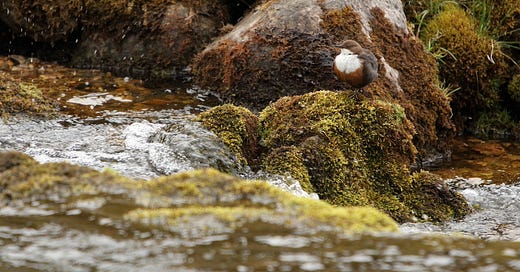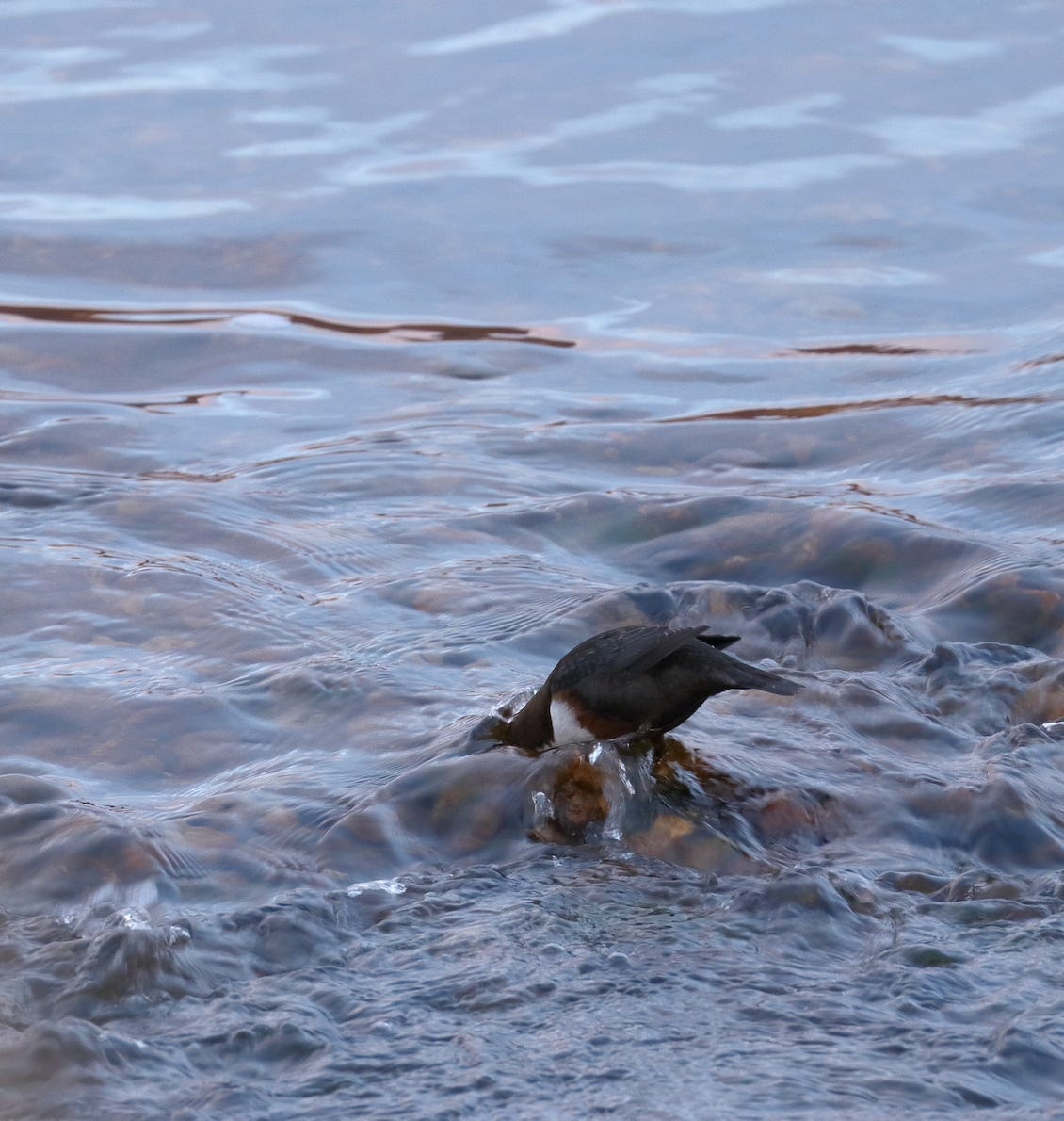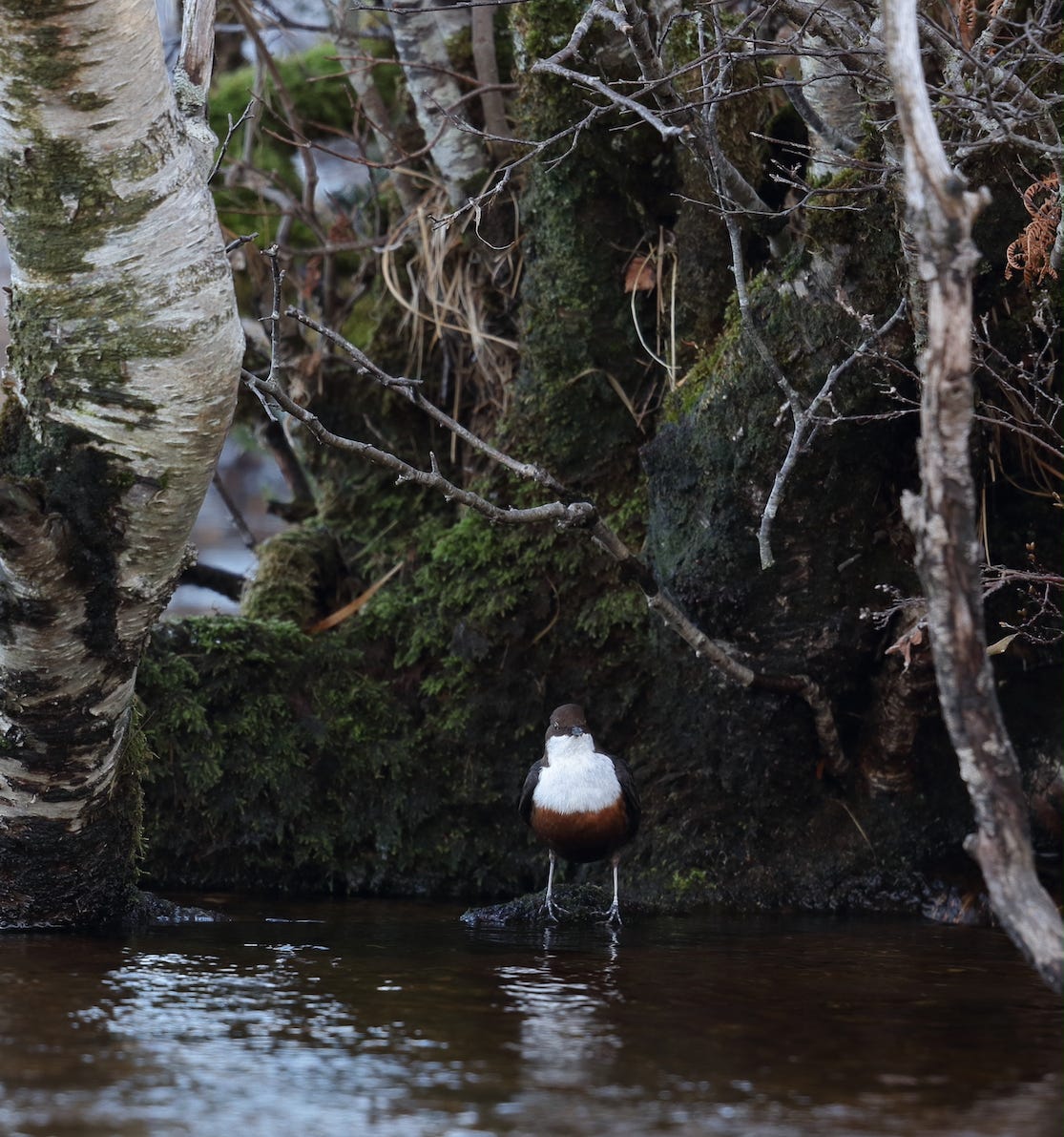An Aquatic Ballet: Observing the European Dipper in its Natural Habitat
Andy speaks to the wee soul of the mountain torrents
FOR A BRIEF MOMENT the wind stopped, the clouds lifted and the sun came out. In that moment I could hear the cool, clear waters of the mountain streams bubbling over the ancient rocks and burrowing into the peat. I paused and as I did, I became aware of this amazing bird perched on rock in mid-river, looking at the water. It was a bit like an overgrown wren with a dazzling, smart white bib.
It was a dipper and it was dipping. In fact, it was performing rapid bowing movements as if in homage to the beautiful water; an effect, all the more enhanced by the pure white of the breast.
Of course, it was looking for food. And once prey is detected, it dives head-first into the water, even into turbulent and fast-flowing water. When on the bottom, it cleverly turns up stones and pebbles, in order to disturb small invertebrates.
The dipper, European dipper (Cinclus cinclus) or white-throated dipper, as it is also known, is found throughout Europe, Middle East, Central Asia and the Indian Subcontinent. The species is divided into several subspecies, based primarily on colour differences, particularly of that white chest band.
If you can see through the refraction of the water surface you will see that after diving in, it often floats downstream for a short distance with partly open wings before emerging.
Mesmerized I watched it slowly walk into the shallow water, submerging its head to search for stonefly larvae and other delicious snacks. It seemed to be grasping wee stones to keep it on the bottom. It walked against the current, with its head down, searching all the time. The current’s force against the bowed back seemed to anchor it on the riverbed.
But the powerful wings were the main tool of locomotion and it walked with semi-open wings. Eventually it emerged on a mossy boulder of quartzite near the bank, seemingly immune to the cold and wet. It started bobbing even more rapidly and furiously blinking at me. I could see the white eyelid repeatedly flashed, and the whitish nictitating membrane which it uses to see underwater. But it was too busy to worry about me and plopped back into the water.
Cold water
Adapted to life in the cold water The Dipper is the world’s only truly aquatic song-bird, the only one given to habitual total immersion as a way of life. I was impressed. It does however have some features to help it in this wild environment in the Highlands of Scotland.
It has very dense plumage, for example, to keep out the icy water, and its feathers are heavily waterproofed with copious oil from its large preen-gland. Its body is streamlined so that the water flows easily past it, and its legs and feet are strong.
Dippers start nesting very early
Now as if this behaviour was not unusual enough it had another surprise for me. When it surfaced for the second time, it had a beak full of aquatic goodies, and flew straight passed me to what I assume was a nest, carefully hidden in the bank under an old wooden footbridge put in by the Estate many years ago.
Dipper nests are cup shaped and mostly made of moss and always have an overhanging moss roof. I don’t think the Dipper would have had young just yet. It is still only March. I can only guess he was bringing home the Sunday lunch for his partner who maybe was incubating some eggs.
The breeding season for these birds starts early and incubation is done exclusively by the female. The young however are fed by both parents. They often nest under bridges, behind waterfalls or on steep overgrown banks and might have several broods. They are also very territorial birds and jealously guard their stretch of river even in winter. It is the only way they can guarantee their food supply for the year and will viciously fight any other dipper who dares cross the invisible border line.

For someone who has the desire and patience it is also very easy to work out where that border line is. When disturbed a Dipper will fly ahead of you giving their distinctive loud tuneless “zit, zit, zit” call. They will keep flying ahead along the line of the water course until they hit an invisible barrier on the river and suddenly they will double back. Rather than attract the attention of their neighbour and rival they would rather take the lesser risk of flying back towards you. So next time you are out and see a gigantic chestnut-bellied wren-like bird bobbing insanely in the middle of a mountain stream, as if constantly curtseying, with an accompanying downward jerk of the tail and blinking of white eye-lid it is probably a dipper - and if you are lucky it probably has young Dipperettes to feed.
Give it respect -it is the soul of the mountain torrents.
Andy Summers, North Highland's Senior Ranger for High Life Highland, is a dedicated naturalist with a deep understanding of the region's diverse ecosystems. His extensive experience in wildlife conservation and passion for preserving North Highland's pristine landscapes make him a vital asset. Andy's work encompasses wildlife observation, environmental education, and passing on a greater appreciation for the area's unique flora and fauna. His commitment to conserving North Highland's natural heritage is evident in his expertise and unwavering dedication.







